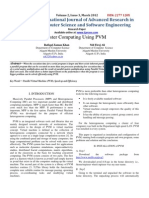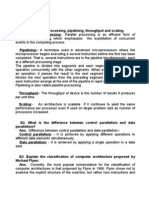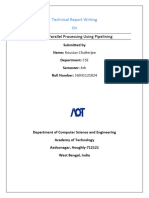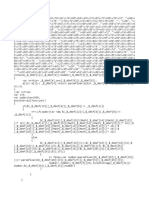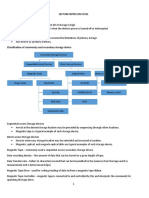0 ratings0% found this document useful (0 votes)
2 viewsCOA Chapter 9
COA Chapter 9
Uploaded by
Samuel EndrisCopyright:
© All Rights Reserved
Available Formats
Download as PPTX, PDF, TXT or read online from Scribd
COA Chapter 9
COA Chapter 9
Uploaded by
Samuel Endris0 ratings0% found this document useful (0 votes)
2 views36 pagesCopyright
© © All Rights Reserved
Available Formats
PPTX, PDF, TXT or read online from Scribd
Share this document
Did you find this document useful?
Is this content inappropriate?
Copyright:
© All Rights Reserved
Available Formats
Download as PPTX, PDF, TXT or read online from Scribd
Download as pptx, pdf, or txt
0 ratings0% found this document useful (0 votes)
2 views36 pagesCOA Chapter 9
COA Chapter 9
Uploaded by
Samuel EndrisCopyright:
© All Rights Reserved
Available Formats
Download as PPTX, PDF, TXT or read online from Scribd
Download as pptx, pdf, or txt
You are on page 1of 36
Chapter 9
PIPELINE AND VECTOR PROCESSING
Outline
Parallel processing
Pipelining
Vector Processing
Array Processors
Parallel processing
Parallel processing is a term used to denote a large
class of technique that are used to provide simultaneous
data processing tasks for the purpose of increasing
computational speed of a computer system.
A parallel processing system is able to perform
concurrent data processing to achieve faster execution
time.
Cont…
Example: While an instruction is being executed
in the ALU, the next instruction can be read
from memory.
System may have two or more ALU to execute
two or more executions at the same time.
The purpose of parallel processing is to speed
up the computer processing capability and
increase its throughput which is the amount of
processing that can be interval of time.
Cont…
Parallel processing is established by
distributing the data among the multiple
functional units.
Figure below shows one possible way of
separating the execution unit into eight
functional units operating in parallel.
Figure: Processor with Multiple Functional Units
Cont…
Parallel processing can be considered under the
following topics:
Pipeline processing
Vector processing
Array processors
Pipelining
Pipelining is a technique of decomposing a
sequential process into sub operations with each sub
process being executed in a special dedicated segment
that operates concurrently with all other segments.
Example: To perform the combined multiple and add
operations with a stream of numbers.
Ai*Bi + Ci for I = 1, 2, 3 ….7
The sub-operations performed in each segment of the
pipeline are as follows:
Figure: Example of Pipeline Processing
Arithmetic Pipeline
Used to implement floating-point operations,
multiplication of fixed-point numbers and similar
computations encountered in scientific problems.
Example: Consider the following arithmetic
operations were pipeline is used in floating-
point adder pipeline binary numbers:
• X=A*2a
• Y=B*2b
Cont…
Where A & B are two fractions that represent
mantissa and a & b are the exponents.
The floating-point addition and subtraction can
be performed in four segments as follows:
Compare the exponents
Align the mantissas
Add or subtract the mantissas
Normalize the result.
The following procedure is outlined in the below figure.
Instruction Pipeline
Instruction pipeline is a technique for overlapping the
execution of several instructions to reduce the
execution time of a set of instructions.
Six Phases in an Instruction Cycle:
Fetch the instruction from memory
Decode the instruction.
Calculate the effective address
Fetch the operands from memory
Execute the instruction
Store the result in the proper place.
Example: Four – segment instruction pipeline
Cont…
The above figure with the abbreviated symbol
FI is the segment that fetches an instruction.
DA is the segment that decodes the instruction
and calculates the effective address
FO is segment that fetches the operand.
EX is the segment that executes the
instruction.
Figure: Timing of Instruction Pipeline
Cont…
In general there are three major difficulties that cause
the instruction pipeline to deviate from its normal
operation:
Resource conflicts caused by access to memory by two
segments at the same time. Most of the self-conflicts can
be resolved by using separate instruction and data
memories.
Data dependency conflicts arise when an instruction
depends on the result of a previous instructions but this
result is not yet available.
Branch difficulties arise from branch and other
instructions that change the value of PC.
RISC Pipeline
The reduced instruction set computer (RISC) is
its ability to use an efficient instruction pipeline.
RISC is a machine with a very fast clock cycle
that executes at the rate of one instruction per
cycle.
Simple Instruction Set
Fixed Length Instruction Format
Register-to-Register Operations
Example: Three- segment instruction pipeline
Cont…
The instruction cycle can be divided into three
sub-operations and implemented in three
segments:
I: Instruction Fetch
A: ALU operation
E: Execute instruction
Vector Processing
Computers with vector processing capabilities
are in demand in specialized application. Some
of the major application areas of Vector
processing are:
Long-range weather forecasting
Petroleum explorations
Seismic data analysis
Cont…
Medical diagnosis
Aerodynamics and space flights simulations
Artificial intelligence and expert systems
Mapping the human genome
Image processing
Vector operations
A vector is an ordered set of a one-dimensional ‘array of data
items. A vector V of length n is represented as row vector by
V=[V1,V2,V3.....Vn].It may be represented as column vector if the
data item are listed in a column. Consequently operations on
vector must be broken down into single computations with
subscripted variables. The element Viif vector V is written asV(I)
and the index I refers to a memory address or register where the
number is stored. To examine the difference between a
convection scalar processor and a vector processor consider the
following Fortran Do loop
• DO 20 I = 1,100
• 20 C(I) =B(I)+A(I) This is a program for adding to
vectors A and B of length 100 to produce a vector C.
Matrix Multiplication
Matrix multiplication is one of the most
computational intensive operations performed in
computer with vector processors. The multiplication
of two n x n matrices consists of n2 inner products
or n3 multiply -add operations. An n x m matrix of
numbers has n rows and m column and may be
considered as constituting a set of n row vector or a
set of m column vectors. Consider, for examples,
the multiplication of two 3x3 matrices A and B.
Cont…
Cont…
The product matrix C is a 3 x 3 matrix whose
elements are related to the elements of A and B
by the inner product:
Figure: Instruction format for vector processor
For example, the number in the first row and
first column of matrix C is calculated by letting
i=1, j=1, to obtain
Cont…
In general, the inner product consists of the sum
of k products terms of the form
Memory Interleaving
Memory interleaving is the technique of using memory
from two or more sources.
An instruction pipeline may require the fetching of
instruction and an operand at the same time from two
different segments .
Similarly, an arithmetic pipeline usually requires two or
more operands to enter the pipeline at the same time
instead of using two memory buses simultaneous access
the memory can be partitioned into a number of modules
connected to a common memory address and data buses.
The advantage of a modular is that it allows the use of a
technique called interleaving
Figure: Multiple module memory organization
Array Processors
An array processor is a processor that performs
computations on large arrays of data.
The terms used to refer to two different types of processors.
An attached array processor is an auxiliary processor
attached to a generally - purpose computer.
It is intended to improve the performance of the host
computer in specific numerical computational tasks.
An SIMD array processor is a processor that has a single
instruction multiple-data organization.
It manipulates vector instructions by means of multiple
functional units responsible to common instruction.
Attached Array Processor
An attached array processor is designed peripheral
for a convectional host computer and its purpose to
enhance the performance of the computer by
providing vector processing complex scientific
applications. It achieves high performance by
means of parallel processing with multiple
functional units. It includes an arithmetic unit
containing one or more pipeline floating adder and
multipliers. The array processor can be
programmed by the user to accommodate variety
arithmetic problems.
Figure: Attached array processor with host computer
SIMD Array Processor
An SIMD array processor is a computer with
multiple processing units operating in parallel. The
processing units Synchronized to perform the same
operation under the control of a common control
unit/thus providing a single instruction stream,
multiple data stream (SIMD)organization. A general
block diagram of an array processor is shown in
below figure. It contains a set of identical
processing elements (PEs) each having a local
memory M.
Figure: SIMD array processor organization
Completed all chapters
Thank you
You might also like
- Problems Chapter 17 Parallel Processsing: 17.14 An Application Program Is Executed On A Nine-Computer Cluster. ADocument4 pagesProblems Chapter 17 Parallel Processsing: 17.14 An Application Program Is Executed On A Nine-Computer Cluster. A8Rafi Ahmad FadhlanNo ratings yet
- Huawei NodeB Fault ManagementDocument526 pagesHuawei NodeB Fault Managementfuckasss84% (45)
- Parallel ProcessingDocument33 pagesParallel ProcessingShivansh tomarNo ratings yet
- Unit 5-2 COADocument52 pagesUnit 5-2 COAmy storiesNo ratings yet
- UNIT-V-Pipeline and Array Processing and Multi ProcessorsDocument51 pagesUNIT-V-Pipeline and Array Processing and Multi ProcessorsdornalankithaNo ratings yet
- Unit 5 1Document21 pagesUnit 5 1shaikshaikkarimulla43No ratings yet
- Chapter 10: Pipeline: ObjectivesDocument8 pagesChapter 10: Pipeline: ObjectivesSteffany RoqueNo ratings yet
- Pipelining PDFDocument19 pagesPipelining PDFriyazpashaNo ratings yet
- Unit - V: Pipeline & Vector Processing and Multi Processors Pipeline and Vector Processing: MultiprocessorsDocument20 pagesUnit - V: Pipeline & Vector Processing and Multi Processors Pipeline and Vector Processing: MultiprocessorsswhnikhilshreyasNo ratings yet
- V-Unit CoDocument18 pagesV-Unit Comohamudsk007No ratings yet
- Pipeline and Vector ProcessingDocument4 pagesPipeline and Vector Processingvinaydarling063No ratings yet
- WINSEM2022-23_CSE4001_ETH_VL2022230503160_Reference_Material_I_05-01-2023_2.3_SIMD_VPDocument25 pagesWINSEM2022-23_CSE4001_ETH_VL2022230503160_Reference_Material_I_05-01-2023_2.3_SIMD_VPrishiNo ratings yet
- 1 - Unit 8 Pipeline - MPDocument12 pages1 - Unit 8 Pipeline - MPever4gitaguptaNo ratings yet
- Chap 5 NewDocument41 pagesChap 5 NewKalayu RedaeNo ratings yet
- Chapter 08 - Pipeline and Vector ProcessingDocument14 pagesChapter 08 - Pipeline and Vector ProcessingBijay MishraNo ratings yet
- PipeliningDocument5 pagesPipeliningprathz182No ratings yet
- Bangabandhu Sheikh Mujibur Rahman Maritime University BangladeshDocument7 pagesBangabandhu Sheikh Mujibur Rahman Maritime University BangladeshSyed Mohaiminul Haque BrintoNo ratings yet
- Parallel Computig AssignmentDocument15 pagesParallel Computig AssignmentAnkitmauryaNo ratings yet
- Computer Architecture 2 MarksDocument32 pagesComputer Architecture 2 MarksArchanavgs0% (1)
- 3.2 Performance EvaluationsDocument18 pages3.2 Performance EvaluationsChetan SolankiNo ratings yet
- Ch9 OfficialDocument48 pagesCh9 OfficialeducationNo ratings yet
- Pipeline and Vector ProcessingDocument48 pagesPipeline and Vector ProcessingJitendra PatelNo ratings yet
- Unit 3 Central Processing Unit and Instructions: StructureDocument24 pagesUnit 3 Central Processing Unit and Instructions: StructureSny Kumar DeepakNo ratings yet
- Computer Organization and Architecture (COA) DEC 2017 Solved Question PaperDocument31 pagesComputer Organization and Architecture (COA) DEC 2017 Solved Question PapermaharshisanandyadavNo ratings yet
- COA - Module-5Document35 pagesCOA - Module-5shruthingowda48No ratings yet
- Chapter 8 Pipeline and Vector ProcessingDocument12 pagesChapter 8 Pipeline and Vector ProcessingSimon Chawinga0% (1)
- Assignment: - 4Document7 pagesAssignment: - 4nikita_gupta3No ratings yet
- Pipeline Processing CoaDocument34 pagesPipeline Processing Coahagos abateNo ratings yet
- Syllabus Topic: - Vector Processing - Vector ProcessorDocument14 pagesSyllabus Topic: - Vector Processing - Vector ProcessorAnanthu RKNo ratings yet
- V2I30063Document4 pagesV2I30063editor_ijarcsseNo ratings yet
- Pipeline and Vector ProcessingDocument18 pagesPipeline and Vector ProcessingPavan Pulicherla100% (1)
- CA Classes-76-80Document5 pagesCA Classes-76-80SrinivasaRaoNo ratings yet
- Parallelism in Computer ArchitectureDocument27 pagesParallelism in Computer ArchitectureKumarNo ratings yet
- CA Classes-241-245Document5 pagesCA Classes-241-245SrinivasaRaoNo ratings yet
- Unit 4 - Parallel Computer Structures WordDocument12 pagesUnit 4 - Parallel Computer Structures WordaljufmuhammadNo ratings yet
- Computer Organization and Architecture Cs2253: Part-ADocument21 pagesComputer Organization and Architecture Cs2253: Part-AjanukarthiNo ratings yet
- DPCO Unit3 2mark Q&ADocument11 pagesDPCO Unit3 2mark Q&Akanimozhi rajasekarenNo ratings yet
- Draw The Block Diagram of Von Neumann Architecture and Explain About Its Parts in Brief AnswerDocument7 pagesDraw The Block Diagram of Von Neumann Architecture and Explain About Its Parts in Brief AnswerhayerpaNo ratings yet
- Parallel Computing: Charles KoelbelDocument12 pagesParallel Computing: Charles KoelbelSilvio DresserNo ratings yet
- CO Module 5 NotesDocument16 pagesCO Module 5 NotesVarsha S LalapuraNo ratings yet
- Unit 5Document29 pagesUnit 5kiran281196No ratings yet
- AssignDocument12 pagesAssignrakbatthNo ratings yet
- Project Report About MultipliersDocument62 pagesProject Report About Multiplierssenthilvl80% (5)
- Unit 6 CoaDocument20 pagesUnit 6 Coavinothagopal31No ratings yet
- Unit 1 (1) HIGH PERFORMANCE COMPUTINGDocument54 pagesUnit 1 (1) HIGH PERFORMANCE COMPUTINGA20Gokul C SNo ratings yet
- MCSE011Document18 pagesMCSE011Anusree AntonyNo ratings yet
- Question Bank For Computer ArchitectureDocument23 pagesQuestion Bank For Computer ArchitecturesuryaNo ratings yet
- Kya HuaDocument4 pagesKya HuaSagar SinghNo ratings yet
- Chapter 9Document28 pagesChapter 9Hiywot yesufNo ratings yet
- Unit 1 Modern ProcessorsDocument52 pagesUnit 1 Modern ProcessorsSudha PalaniNo ratings yet
- Week 3 - Four Instruction CPUDocument8 pagesWeek 3 - Four Instruction CPUGame AccountNo ratings yet
- Wa0004.Document11 pagesWa0004.Reeshma.GogulaNo ratings yet
- UNIT-3: MIPS InstructionsDocument15 pagesUNIT-3: MIPS InstructionsMukeshram.B AIDS20No ratings yet
- ArchitectureDocument15 pagesArchitectureT024KOUSTAV CHATTERJEENo ratings yet
- COA Unit-5Document144 pagesCOA Unit-5varshiniveeramalla07No ratings yet
- Unit-V NEWDocument21 pagesUnit-V NEWsandhya vaniNo ratings yet
- UNIT - 5 Pipeling ConceptDocument15 pagesUNIT - 5 Pipeling Conceptvijaykrishna2k24No ratings yet
- Chapter 5 - CO - BIM - IIIDocument7 pagesChapter 5 - CO - BIM - IIIAnkit ShresthaNo ratings yet
- VI. Implicit Parallelism - Instruction Level VI. Implicit Parallelism Instruction Level Parallelism. Pipeline Superscalar & Vector P ProcessorsDocument26 pagesVI. Implicit Parallelism - Instruction Level VI. Implicit Parallelism Instruction Level Parallelism. Pipeline Superscalar & Vector P Processorstt_aljobory3911No ratings yet
- ECE 452: Computer Organization and DesignDocument9 pagesECE 452: Computer Organization and Designdermeister1988No ratings yet
- Python Advanced Programming: The Guide to Learn Python Programming. Reference with Exercises and Samples About Dynamical Programming, Multithreading, Multiprocessing, Debugging, Testing and MoreFrom EverandPython Advanced Programming: The Guide to Learn Python Programming. Reference with Exercises and Samples About Dynamical Programming, Multithreading, Multiprocessing, Debugging, Testing and MoreNo ratings yet
- Unit - 3 PCDocument23 pagesUnit - 3 PCnanobala15No ratings yet
- Pla Gea12903a HRDocument8 pagesPla Gea12903a HRJuan Carlos Sanchez CastilloNo ratings yet
- Encoder 3Document110 pagesEncoder 3Jekonia JakobNo ratings yet
- FreeBitcoin Script Roll 10000Document4 pagesFreeBitcoin Script Roll 10000josuerrNo ratings yet
- Using The Series 8130 RTU With FMDocument14 pagesUsing The Series 8130 RTU With FMАлександрNo ratings yet
- Swapnil Tiwari: Seasoned Senior Principal Eng With 12+ Years of Experience in The Following Domain AlsoDocument14 pagesSwapnil Tiwari: Seasoned Senior Principal Eng With 12+ Years of Experience in The Following Domain Alsoswapnil tiwariNo ratings yet
- TR-3824 Storage Efficiency and Best Practices For Microsoft Exchange Server 2010 Technical ReportDocument22 pagesTR-3824 Storage Efficiency and Best Practices For Microsoft Exchange Server 2010 Technical ReportDavid Hernan Lira CarabantesNo ratings yet
- 1.3 Component of Information SystemDocument17 pages1.3 Component of Information SystemEnchanting BerryNo ratings yet
- Manual Gigabyte Ga-B75m-D3h - PT PDFDocument6 pagesManual Gigabyte Ga-B75m-D3h - PT PDFkdlao1969No ratings yet
- Smart Parking SystemDocument36 pagesSmart Parking SystemSomething TrickyNo ratings yet
- EEM336 mt1 Example QuestionsDocument17 pagesEEM336 mt1 Example QuestionsMustafa TuraçNo ratings yet
- Chapter 4-BIOS and CMOSDocument59 pagesChapter 4-BIOS and CMOSisayasteshomaNo ratings yet
- Fanuc 30i SRAM BackupDocument6 pagesFanuc 30i SRAM BackupRelu ChiruNo ratings yet
- FSMD Block Diagram: Datapath ElementsDocument19 pagesFSMD Block Diagram: Datapath ElementsPhạm Văn DũngNo ratings yet
- Weeemake Bluetooth Gamepad Controller ManualDocument15 pagesWeeemake Bluetooth Gamepad Controller ManualEugenia San JulianNo ratings yet
- ROVER84 V4 Lite Via Keyboard Instruction Manual SoftDocument2 pagesROVER84 V4 Lite Via Keyboard Instruction Manual SoftbassletdxNo ratings yet
- Os MCQDocument14 pagesOs MCQmohamedmohy37173No ratings yet
- 50PFH400.88 Tpn14.1e - La - 312278519598 - 141107 PDFDocument253 pages50PFH400.88 Tpn14.1e - La - 312278519598 - 141107 PDFSokol Kadare50% (2)
- Como Baixar Firmware Lollipop Sony e Converter para FTFDocument17 pagesComo Baixar Firmware Lollipop Sony e Converter para FTFkteste20009178No ratings yet
- Anna University: Chennai - 600 025Document4 pagesAnna University: Chennai - 600 025RamJiDRNo ratings yet
- Computer Organization Questions and Answers - Set-2Document6 pagesComputer Organization Questions and Answers - Set-2Mouli Mandal100% (2)
- Vmware Vsphere Version Comparison: Across VersionsDocument7 pagesVmware Vsphere Version Comparison: Across Versionsmohamad septianto nugrohoNo ratings yet
- 8051 Memory OrganizationDocument10 pages8051 Memory OrganizationHiru Purushothaman HirudayanathanNo ratings yet
- Syllabus: Microcontrollers 4 Sem Ece/TceDocument60 pagesSyllabus: Microcontrollers 4 Sem Ece/TceRaviNo ratings yet
- Zoo Management System: Project Synopsis OnDocument9 pagesZoo Management System: Project Synopsis OnDeepak Kumar0% (1)
- Lecture Notes On Cc101 Limitations of Primary StorageDocument4 pagesLecture Notes On Cc101 Limitations of Primary StorageRolando Carlos FloresNo ratings yet
- Veritas Volume Manager Known Issues: Installation and Upgrade IssuesDocument70 pagesVeritas Volume Manager Known Issues: Installation and Upgrade Issuessa9825No ratings yet
- Exceptional Control FlowDocument45 pagesExceptional Control Flowabdulkerimaragaw936No ratings yet





























